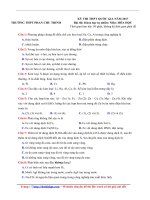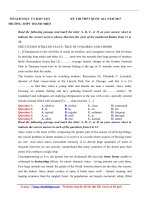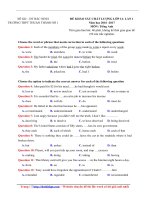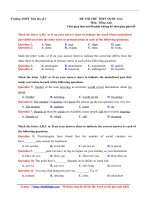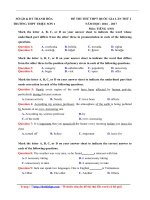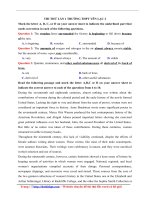- Trang chủ >>
- THPT Quốc Gia >>
- Ngoại Ngữ
thpt nguyen viet thuat nghe an mon tieng anh lan 1 nam 2017 file word co loi giai
Bạn đang xem bản rút gọn của tài liệu. Xem và tải ngay bản đầy đủ của tài liệu tại đây (162.99 KB, 16 trang )
SỞ GD & ĐT NGHỆ AN
ĐỀ THI THỬ THPT QUỐC GIA LẦN 1
TRƯỜNG THPT LÊ VIẾT THUẬT
NĂM HỌC 2016 – 2017
Môn: Tiếng Anh
Thời gian làm bài: 60 phút
Mark the letter A, B, C, or D to indicate the word that differs from the other three in the
position of the primary stress in each of the following questions.
Question 1:
Question 2:
A. employment
A. listen
B. company
B. follow
C. atmosphere
C. offer
D. customer
D. precede
Mark the letter A, B, C, or D to indicate the word whose underlined part differs from the
other three in pronunciation in each of the following questions.
Question 3:
Question 4:
A. ancient
A. approached
B. vertical
B. sacrificed
C. compose
C. unwrapped
D. eradicate
D. obliged
Mark the letter A, B, C or D to indicate the word SIMILAR in meaning to the underlined
word(s) in each of the following questions.
Question 5: The small white flowers are my favorite. They give off a wonderful honey smell
A. end
B. stop
C. release
D. melt
Question 6: As a result of sophisticated technology, this device has several advantages over
other products.
A. advanced
B. traditional
C. detrimental
D. constructive
Mark the letter A, B, C or D to indicate the underlined part that needs correction in each
of the following questions.
Question 7: Dogs that are trained to lead the blind must be loyalty, intelligent and calm.
A. Dogs that
B. trained
C. the
D. loyalty
Question 8: He told us about the hotel that he had stayed the previous summer.
A. told
B. hotel that
C. had
D. previous summer
Question 9: The assumption that smoking has bad effects on our health have been proved.
A. smoking
B. effects
C. on
D. have been proved.
Mark the letter A, B, C or D to indicate the correct response to each of the following
exchanges.
Trang 1 – Website chuyên đề thi thử file word có lời giải
Question 10: Mary and Jane are classmates. They are talking about Mary’s new hairstyle. Jane: What an attractive hairstyle you have got, Mary! - Mary: _______
A. Well, I’m afraid not.B. Thank you for your compliment.
C. You can’t believe it! D. I can’t agree with you more.
Question 11: A mother is complaining to her son that his room gets dusty. - Mother: Haven’t
you tidied up your room yet? - Son: _______
A. I will, after I do all the exercises in my textbook.
B. I have my hands full with my tidying.
C. The more I tidy, the worse it gets.
D. Why don’t you give me a hand with cleaning?
Mark the letter A, B, C, or D to indicate the sentence that is closest in meaning to each of
the following questions.
Question 12: They never made us do anything we didn’t want to do.
A. We had never been made to do anything we didn’t want to do.
B. We were never made to do anything we didn’t want to do.
C. We were never allowed to do anything we wanted to do.
D. We were never made do anything we didn’t want to do.
Question 13: The worker only called off the strike after a new pay offer.
A. Not until a new pay was offered, the workers called off the strike.
B. The worker called off the strike only when a new pay offers.
C. A new pay was offered, which made the strike call off.
D. Not until a new pay was offered did the workers call off the strike.
Question 14: "Don't forget to give the book back to Mary", said he.
A. He advised me to give the book back to Mary.
B. He reminded me to forget to give the book back to Mary.
C. He reminded me to give the book back to Mary.
D. He advised me to forget to give the book back to Mary.
Mark the letter A, B, C, or D to indicate the sentence that best combines each pair of
sentences in the following questions.
Question 15: Her living conditions were not good. However, she studied very well.
A. Living in difficult conditions forced her to study very well.
B. She studied very well just because she lived in difficult conditions.
Trang 2 – Website chuyên đề thi thử file word có lời giải
C. Living in difficult conditions, she had no choice but to study well.
D. Difficult as her living conditions were, she studied very well.
Question 16: He telephoned from a public call-box. He didn’t want the call to be traced to
his own address
A. He telephoned from a public call-box in order the call could be traced to his own address.
B. He telephoned from a public call-box in order that the call could be traced to his own
address.
C. He telephoned from a public call-box so that the call couldn’t be traced to his own
address.
D. He telephoned from a public call-box so the call can’t be traced to his own address.
Mark the letter A, B, C or D to indicate the word(s) OPPOSITE in meaning to the
underlined word in each of the following questions.
Question 17: Henry hoped that his sons would someday take over his retail business and
maintain the high level of customer service and satisfaction that Henry valued so much.
A. eliminate
B. continue
C. uphold
D. connect
Question 18: Tom Swayer became internationally famous for his novels.
A. well known
B. celebrated
C. unknown
D. infamous.
Read the following passage and mark the letter A, B, C or D to indicate the correct answer
to each of the questions.
Although people drive in all countries, the rules can be quite different between nations and
areas. For this reason, you should always learn the laws before you decide to drive in a
foreign country. If you are not careful, you can get into trouble since the rules might be very
different from what you are used to. For example, you can find some big differences in laws
related to the minimum driving age, the appropriate side of the road to drive on, and mobile
phone use while driving.
In the U.S., people who live in Alaska may obtain a learner’s permit (legal permission to
drive while being supervised) at the age of fourteen. This is quite different from the driving
laws of Niger, where a person must be at least twenty-three years old to drive. If you are
inquisitive to know the minimum driving age in most countries, the answer is eighteen. It
may also surprise you to learn that not every country allows its citizens to drive, although
most of them do. For example, women are not allowed to drive in Saudi Arabia no matter
how old they are. Instead, they must have a male family member or hired male driver to
travel by car.
Trang 3 – Website chuyên đề thi thử file word có lời giải
Driving on the right or left side of the road also varies. For instance, in Great Britain, Cyprus,
Australia, India, and Malaysia people drive on the left. However, in the U.S., Mexico, France,
and Canada people are required to drive on the right. As a matter of fact, one country can
have different driving rules for different areas. People in Hong Kong drive on the left, while
drivers in other parts of China use the right side of the road.
Other driving laws that are different between countries include those related to using mobile
phones. In Japan, using any kind of mobile phone device is illegal, even if you do not need to
hold the phone with your hands. However, in Argentina and Australia, drivers are allowed to
talk on their mobile phones as long as they do not use their hands.
You might also find it interesting to learn that some countries have very unusual laws. For
example, in the country of Cyprus, it is against the law to eat or drink anything while driving.
Even more interesting is that in Germany, there is a famous road called the Autobahn, where
certain parts have no speed limit at all!
Question 19: Which of the following is TRUE according to the passage?
A. Females can drive a car in Saudi Arabia.
B. People in India drive on the right side of the road.
C. You can drive as fast as you want on all parts of the German Autobahn.
D. You are not allowed to hold your mobile phone and talk while you drive in Australia.
Question 20: Which of the following is NOT mentioned as a main difference in driving laws
in this passage?
A. Drink driving limit
B. Legal driving age
C. Right or left hand traffic
D. Safety calls
Question 21: According to the passage, it is illegal to eat or drink while driving in_______.
A. Cyprus
B. Great Britain
C. China
D. Australia
Question 22: It is important to learn the laws before driving in a foreign country
because_______.
A. It is fun to learn about other countries’ driving laws.
B. You can get into trouble when you are not used to another country’s rules.
C. You can have a car accident if you do not know the rules.
D. It helps you identify the appropriate side of the road to drive on.
Question 23: The word “inquisitive” in paragraph 2 can be best replaced by _______.
A. indifferent
B. concerned
C. nosy
D. curious
Question 24: The word “those” in paragraph 4 refers to_______.
A. drivers
B. mobile phones
C. driving laws
D. countries
Trang 4 – Website chuyên đề thi thử file word có lời giải
Question 25: What is the main idea of the passage?
A. Driving in all countries shares a common purpose.
B. There are differences in laws related to driving among countries.
C. Countries have different ways to enact laws on driving.
D. People in different countries drive on different sides of the road.
Mark the letter A, B, C or D to indicate the correct answer to each of the following
questions.
Question 26: _______that Jane was able to retire at the age of 50.
A. Her business was successful
B. So successful was her business
C. So successful her business was
D. So was her successful business
Question 27: My supervisor is angry with me. I didn’t do all the work I _______ last week.
A. need to have done B. should have done
C. must have done
D. may have done
Question 28: I _______along the street when I suddenly heard footsteps behind me.
A. was walking
B. am walking
C. walk
D. walked
Question 29: It is imperative that he _______ the school regulations.
A. would obey
B. obey
C. will obey
D. obeys
Question 30: _______, the more terrible the terrorism will become.
A. The more powerful weapons are
B. The more weapons are powerful
C. The weapons more powerful are
D. Weapons are the more powerful
Question 31: Mr. Brown was obliged to pay damages to his neigbours in _______for the
devastations his pet dogs made in their garden.
A. penalty
B. reparation
C. reward
D. compensation
Question 32: Don’t _______to conclusions, we don’t yet know all the relevant facts.
A. hurry
B. rush
C. run
D. jump
Question 33: Losing my job was a great shock, but I think I’m _______ it.
A. seeing to
B. putting up with
C. standing for
D. getting over
Question 34: The biggest company in our local area is _______the verge of bankruptcy.
A. on
B. in
C. at
D. from
Question 35: Mark enjoys having fun by causing trouble. He’s a very _______ boy.
A. strong-willed
B. mischievous
C. obedient
D. well-behaved
Question 36: He spent the entire night thinking and in the end _______a brilliant idea.
A. came up to
B. catch up with
C. came up with
D. get through to
Question 37: His achievements were partly due to the____________ of his wife.
Trang 5 – Website chuyên đề thi thử file word có lời giải
A. assist
B. assistant
C. assisted
D. assistance
Read the following passage and mark the letter A, B, C, or D to indicate the correct word
or phrase that best fits each of the numbered blanks.
TRANSPORT IN THE CITY
Transport plays an important role in our daily lives and in the quality of life in our city.
Moreover, the individual decisions we make when we choose how to (38)_______our
destination can have an impact (39) _____other people – longer traffic queues, worsening air
quality, greater number of accidents and health problems. Providing more transport options
will create a transport system that is safe, clean and fair.
Increasing use of the car has led to greater (40) ____ of the impact it has and the real cost to
us – for our health, for the economy and for the environment. We want our city to become a
successful, cosmopolitan city by the sea, (41) _______people can enjoy a high quality of life
in a pleasant environment. To (42)_______this we need to make sure everyone has access to
the services and facilities they need, through a choice of as many different means of transport
as possible.
Question 38:
Question 39:
Question 40:
Question 41:
Question 42:
A. get
A. on
A. interest
A. whom
A. decide
B. reach
B. about
B. awareness
B. which
B. consider
C. arrive
C. of
C. campaign
C. where
C. use
D. come
D. in
D. transfer
D. that
D. achieve
Read the following passage and mark the letter A, B, C or D to indicate the correct answer
to each of the questions.
There is a strange paradox to the success of the Asian education model. On the one hand,
class sizes are huge by Western standards with between 30 and 40 students per class, in
countries like Japan and Korea. On the other hand, school children in developed Asian
economies rank among the highest in the world for academic achievement in the areas of
science and mathematics, especially on standardised tests. Meanwhile, British secondary
school students fail to shine in conditions most educational researchers would say are far
more likely to help them succeed.
Classroom management seems to be easier in places like Korea, and perhaps lessons are more
effective as a direct consequence. After all, we are only too aware of the decline in discipline
standards in our own school: belligerent and disrespectful students appear to be the norm
these days. Teachers in Britain seem powerless to control what happens anymore. Surely this
Trang 6 – Website chuyên đề thi thử file word có lời giải
situation cannot create a very effective learning environment, so perhaps the number of
students is far less relevant than is the manner in which they conduct themselves.
But there are other factors to consider, too. There is the home environment. The traditional
family unit still remains relatively intact in Korea. Few children come from broken homes, so
there is a sense of security, safety and trust both at home and at school. In Britain meanwhile,
one in every two marriages fails and divorce rates are sky high. Perhaps children struggle to
cope with unstable family conditions and their only way to express their frustration is by
misbehaving at school.
But while the Japanese, Korean and Asian models generally do seem to produce excellent
results, the statistics don’t tell the whole truth. You see, behind those great maths and science
scores, there is a quite remarkable work ethic. Asian students tend to put their education
before literally everything else. They do very few extracurricular activities and devote far
more time to their studies than their British peers.
There has been a lot of attention and praise given to these Asian models and their
“impressive” statistics of late. And without question, some of this praise is justified, but it
seems to be a case of two extremes in operation here. At one end, there is the discipline and
unbelievably hard work ethic of the Asian students – success in education before all else. At
the other end, British students at times appear careless and extremely undisciplined by
comparison, but at least they Do have the free time to enjoy their youth and explore their
interests. Is either system better outright? Or is it perhaps about time we stopped comparing
and started trying to combine the best bits of both, so that we can finally offer our students a
balanced, worthwhile education
Question 43: The word “They” in paragraph 4 refers to_______.
A. British students
B. Asian students
C. Korean students
D. Japanese students
Question 44: British secondary school students_______.
A. have larger class sizes
B. fail at school more than they succeed
C. do better on stadardised tests
D. enjoy better classroom conditions
Question 45: What can be implied from the writer’s opinion of the two educational systems
discussed?
A. The Asian system is clearly better.
B. The British system is too strict.
C. Neither system is perfect.
D. Both systems are quite satisfactory for different reasons.
Question 46: The traditional family unit_______.
Trang 7 – Website chuyên đề thi thử file word có lời giải
A. is more common in Korean than in Britain
B. is disappearing in Korean due to high divorce rates
C. is bad for children that come from broken homes
D. is unstable in Korean due to conditions in the home
Question 47: What does the writer mean when he says there is a “paradox” in the Asian
education model?
A. There are too many students in each class.
B. You would expect larger classes to get poorer results but they do not.
C. Class sizes are much smaller in other parts of the world.
D. Asian students outperform their peers in other countries.
Question 48: What does the writer suggest might make lessons in Korean schools more
successful than in Britain?
A. Better teacher
B. Better school Boards of Management
C. More effective lesson planning
D. Better discipline
Question 49: The word “unstable ” in paragraph 3 can be best replaced by_______.
A. unsteady
B. unchangeable
C. unpredictable
D. unimportant
Question 50: According to the writer, Asian students_______.
A. focus too much on recreational activities
B. don’t have as good a work ethic as British ones
C. don’t allow themselves much time to relax and have fun
D. make a big deal of their good results
Trang 8 – Website chuyên đề thi thử file word có lời giải
Đáp án
1-A
11-A
21-A
31-D
41-C
2-D
12-B
22-B
32-D
42-D
3-A
13-D
23-D
33-D
43-B
4-D
14-C
24-C
34-A
44-B
5-C
15-D
25-B
35-B
45-C
6-A
16-C
26-B
36-C
46-A
7-D
17-A
27-B
37-D
47-B
8-B
18-C
28-A
38-B
48-D
9-D
19-D
29-B
39-A
49-A
10-B
20-A
30-A
40-B
50-C
LỜI GIẢI CHI TIẾT
Question 1: Đáp án A
Employment /ɪmˈplɔɪmənt/
Company /ˈkʌmpəni/
Atmosphere /ˈætməsfɪə(r)/
Customer /ˈkʌstəmə(r)/
=> Trọng âm vào âm tiết thứ 2, còn lại âm tiết thứ 1.
Question 2: Đáp án D
Listen /ˈlɪsn/
Follow /ˈfɒləʊ/
Offer /ˈɒfə(r)/
Precede /prɪˈsiːd/
=> Trọng âm vào âm tiết thứ 2, còn lại âm tiết thứ 1.
Question 3: Đáp án A
Ancient
/ˈeɪnʃənt/
Vertical /ˈvɜːrtɪkl/
Compose /kəmˈpoʊz/
Eradicate /ɪˈrỉdɪkeɪt/
Câu A phát âm là /ʃ/, cịn lại phát âm là /k/
Question 4: Đáp án D
Approached /əˈproʊtʃt/
Sacrificed /ˈsỉkrɪfaɪst/
Unwrapped /ʌnˈrỉpt/
Obliged /əˈblaɪdʒd/
Câu D phát âm là /d/, cịn lại phát âm là /t/
Question 5: Đáp án C
Câu này dịch như sau: Tơi thích những bơng hoa nhỏ màu trắng kia. Chúng tỏa ra mùi hương
rất ngọt ngào dễ chịu.
Trang 9 – Website chuyên đề thi thử file word có lời giải
Give off = release: tỏa ra, nhả ra
Question 6: Đáp án A
Câu này dịch như sau: Như là kết quả của sự cải tiến công nghệ, thiết bị này ưu việt hơn hẳn
so với những sản phẩm khác.
Sophisticated = advanced: tiên tiến
Question 7: Đáp án D
Câu này dịch như sau: Những con chó được huấn luyện để dẫn đường cho người mù thì phải
trung thành, thơng minh và bình tĩnh.
Sau động từ to be phải là một tính từ. Loyalty -> Loyal
Question 8: Đáp án B
Câu này dịch như sau: Anh ấy kể chúng tôi nghe về cái khách sạn mà anh ấy ở mùa hè năm
ngối.
That -> where vì ở đây cần một mệnh đề quan hệ chỉ nơi chốn
Question 9: Đáp án D
Câu này dịch như sau: Giả thuyết về việc hút thuốc lá có hại cho sức khỏe đã được chứng
minh là đúng.
Động từ bị chia theo chủ ngữ thứ nhất là The assumption. Have been proved -> Has been
proved
Question 10: Đáp án B
Câu này dịch như sau: Mary và Jane là bạn cùng lớp. Họ đang nói chuyện về kiểu tóc mới
của Mary. - Jane: Cậu có một kiểu tóc thật ấn tượng Mary à. - Mary: Cảm ơn cậu đã quá
khen.
Khi có một ai đó khen mình thì thường câu đáp sẽ là: Thank you for your compliment.
Question 11: Đáp án A
Câu này dịch như sau: Người mẹ đang phàn nàn về cái phòng bừa bộn của con trai mình. Mẹ: Con vẫn chưa dọn phòng à con trai? - Con: Để con làm nốt bài tập rồi con dọn nha mẹ.
Câu trả lời hợp lý nhất khi người con nói với mẹ của mình.
Question 12: Đáp án B
Câu này dịch là: Họ chưa bao giờ bắt chúng tôi làm những việc mà chúng tôi không muốn.
Dạng chủ động: Somebody + make + somebody + do somethingDạng bị động: Somebody +
be made + to do something
Động từ "made" ở thì quá khứ đơn nên chọn B.
Question 13: Đáp án D
Câu này dịch là: Công nhân chỉ tiếp tục làm việc khi mức lương mới được đề xuất.
Trang 10 – Website chuyên đề thi thử file word có lời giải
Cấu trúc Not until ... trợ động từ + somebody + do something: Mãi đến khi ... thì ai đó mới
chịu làm gì
Question 14: Đáp án C
Câu này dịch là: "Đừng quên mang trả quyển sách này cho Mary nhé", anh ấy nói.
Cấu trúc: remind + somebody + to do something: nhắc nhở ai làm gì.
Question 15: Đáp án D
Câu này hiểu là: Điều kiện sống của cô ấy không tốt lắm. Tuy nhiên, cô ấy học rất giỏi.
Cấu trúc: Tính từ + as + S + be, Phrase: Vế đầu diễn tả một cái gì đó như thế nào, vế sau diễn
tả một hành động trái ngược.
Question 16: Đáp án C
Câu này hiểu là: Anh ta gọi điện từ một chiếc hộp điện thoại công cộng. Anh ấy không muốn
bị người khác phát hiện ra địa chỉ nhà của mình qua cuộc gọi.
Cấu trúc: "so that" để diễn tả một mục đích nào đó
Question 17: Đáp án A
Câu này hiểu là: Henry hy vọng một ngày nào đó con trai của ơng sẽ nắm giữ mối kinh doanh
của mình và duy trì được dịch vụ chăm sóc khách hàng và sự hài lòng của họ ở cấp độ cao
mà Henry cực kỳ trân quý.
maintain: duy trì
eliminate: phá hủy
Question 18: Đáp án C
Tom Swayer trở nên nổi tiếng toàn thế giới nhờ vào cuốn tiểu thuyết của ông.
famous: nổi tiếng (vì điều gì đó tốt đẹp)infamous: khét tiếng (vì điều xấu)
Question 19: Đáp án D
Dựa theo bài viết, câu nào sau đây là đúng?A. Phụ nữ có thể lái xe ở Ả-rập Xê-útB. Người
dân Ấn Độ lái xe ở bên phải đường.C. Bạn có thể đi nhanh như thế nào cũng được nếu bạn
muốn ở mọi nơi trên con đường Autobahn của Đức.D. Bạn không được vừa cầm điện thoại
vừa nói chuyện khi đang lái xe nếu bạn đang ở Úc.
Câu cuối đoạn 4: However, in Argentina and Australia, drivers are allowed to talk on their
mobile phones as long as they do not use their hands. Câu này hiểu là: [...] ở Úc, lái xe có thể
nói chuyện điện thoai, chỉ cần họ khơng cầm nó ở trên tay.
Question 20: Đáp án A
Điều nào không được đề cập đến như là một sự khác biệt trong luật lệ giao thông?
A. Giới hạn sự lái xe khi có dùng đồ uống
B. Tuổi hợp pháp để lái xe
Trang 11 – Website chuyên đề thi thử file word có lời giải
C. Lái xe ở bên trái hay bên phải đường
D. Những cuộc gọi an toàn
Question 21: Đáp án A
Theo bài viết, ăn uống khi đang lái xe là phạm pháp khi bạn đang ở?
A. Cộng hịa Síp
B. Anh
C. Trung QuốcD. Úc
Câu 2 đoạn cuối: For example, in the country of Cyprus, it is against the law to eat or drink
anything while driving
Question 22: Đáp án B
Việc tìm hiểu về pháp luật trước khi lái xe ở nước ngồi là vơ cùng quan trọng bởi...
A. Thật thú vị khi biết thêm về luật giao thơng.
B. Bạn có thể sẽ gặp rắc rồi nếu không hiểu rõ về quy định luật pháp của một nước nào đó.
C. Bạn sẽ có thể gặp tai nạn nếu khơng biết luật.
D. Nó sẽ giúp bạn xác định được phần đường đúng để bạn có thể đi vào.
Question 23: Đáp án D
Từ ''inquisitive" ở đoạn 2 có thể được thay thế bởi từ nào?
inquisitive = curious: tò mò
Question 24: Đáp án C
Từ "those" ở đoạn 4 đề cập đến cái gì?
Đáp án: driving laws
Question 25: Đáp án B
Ý chính của bài văn này là gì?
A. Việc lái xe ở tất cả các quốc gia đều có một mục đích chung.
B. Có những sự khác nhau trong luật giao thông giữa các quốc gia với nhau.
C. Các quốc gia có những cách khác nhau để ban hành luật pháp liên quan đến việc lái xe.
D. Người dân ở những nơi khác nhau thì lái xe ở những bên khác nhau của con đường.
Chúng ta có thể nhận thấy, B là đáp án phù hợp nhất cho câu hỏi này.
Question 26: Đáp án B
Câu này hiểu là: ... mà Jane có thể nghỉ hưu ở tuổi 50.
Cấu trúc: So + tính từ + be + danh từ + that + S + V là đảo ngữ của cấu trúc so...that...
Question 27: Đáp án B
Câu này hiểu là: Quản lý của tơi đang rất tức giận vì tơi khơng làm đủ số cơng việc mà nhẽ ra
tơi nên hồn thành từ tuấn trước.
Trang 12 – Website chuyên đề thi thử file word có lời giải
should have done: đáng nhẽ ra nên hoàn thành từ trướcneed to have done: cần phải hoàn
thành từ trướcmust have done: chắc chắn đã hoàn thành từ trướcmay have done: có thể đã
hồn thành từ trước
Question 28: Đáp án A
Câu này hiểu là: Tôi đang dạo bộ dọc con đường thì bỗng dưng nghe thấy tiếng bước chân
đằng sau.
Trong 1 câu có 2 vế diễn tả 2 hành động đã xảy ra trong quá khứ, hành động nào xảy ra xen
vào hành động khác thì dùng với quá khứ đơn, còn hành động bị xen vào dùng với quá khứ
tiếp diễn.
Question 29: Đáp án B
Câu này hiểu là: Việc cậu ấy chấp hành nội quy của trường là vô cùng cấp thiết.
Cấu trúc: It is + be + that + S + V(nguyên thể)
Question 30: Đáp án A
Câu này hiểu là: ..., chủ nghĩa khủng bố sẽ ngày càng trở nên tồi tệ.
Cấu trúc so sánh kép: The more + tính từ/trạng từ + S + V, the more + tính từ/trạng từ + S + V.
Question 31: Đáp án D
Câu này hiểu là: Ông Brown bị buộc phải bồi thường cho những thiệt hại mà chú chó của ơng
gây ra trong khu vườn của hàng xóm.
"pay in compensation: bồi thường thiệt hại
Question 32: Đáp án D
Câu này hiểu là: Đừng vội đưa ra kết luận, chúng ta vẫn còn chưa biết hết những sự thật liên
quan.
jump to conclusions: đưa ra kết luận
Question 33: Đáp án D
Câu này hiểu là: Mất việc quả là một cú sốc với tôi, nhưng tôi nghĩ tôi sẽ vượt qua sớm thôi.
get over something: vượt qua cái gì
Question 34: Đáp án A
Câu này hiểu là: Công ty lớn nhất trong khu vực của chúng ta đang ở trên bờ vực phá sản.
on the verge of bankruptcy: trên bờ vực phá sản.
Question 35: Đáp án B
Câu này hiểu là: Mark rất thích thú với việc tạo ra rắc rối. Đó là một cậu bé tinh nghịch.
mischievous: tinh nghịch
Question 36: Đáp án C
Trang 13 – Website chuyên đề thi thử file word có lời giải
Câu này hiểu là: Anh ấy dành cả buổi tối để suy nghĩ và rốt cuộc thì cũng đã đưa ra được một
sáng kiến tuyệt vời.
come up with: đưa ra
Question 37: Đáp án D
Câu này hiểu là: Những gì anh ấy đạt được một phần là nhờ vào sự hỗ trợ từ người vợ.
assistance: sự hỗ trợ
Question 38: Đáp án B
reach + một địa điểm, nơi chốn (không dùng giới từ)
get + to + địa điểm
arrive + at/in + địa điểm
come + to + địa điểm
Question 39: Đáp án A
impact + on somebody/something: ảnh hưởng đến ai/cái gì
Question 40: Đáp án B
interest: sụ thích thú
awareness : sự nhận ra
campaign: chiến dịch
transfer: sự chuyển đổi
Question 41: Đáp án C
Chỗ trống cần một mệnh đề quan hệ chỉ nơi chốn => đáp án C
Question 42: Đáp án D
achive: đạt được
decide: quyết định
consider: xem xét
use: lựa chọn
Question 43: Đáp án B
Từ “They” được in đậm trong đoạn 4 được thay thế cho từ nào? A. Học sinh Anh Quốc B.
Học sinh châu Á C. Học sinh Hàn Quốc D. Học sinh Nhật Bản
Asian students tend to put their education before literally everything else. They do very few
extracurricular activities and devote far more time to their studies than their British peers. =>
Học sinh châu Á thường đặt việc học lên hàng đầu. Họ ít khi tham gia các hoạt động ngoại
khóa và dành thời gian cho học tập nhiều hơn các học sinh ở Anh
Question 44: Đáp án B
Câu này nói về học sinh cấp 2 ở Anh quốc.
Trang 14 – Website chuyên đề thi thử file word có lời giải
Câu cuối đoạn 1 có nói: Meanwhile, British secondary school students fail to shine in
conditions most educational researchers would say are far more likely to help them succeed.
Nghĩa là, học sinh cấp 2 ở Anh thất bại trong những điều kiện mà các nhà nghiên cứu giáo
dục cho rằng đáng nhé phải giúp các em ấy thành công.
Question 45: Đáp án C
Có thể suy ra được điều gì từ quan điểm của tác giả về hai hệ thống giáo dục được nhắc tới?
A. Hệ thống của châu Á rõ rang là tốt hơn
B. Hệ thống của người Anh quá nghiêm khắc
C. Khơng có hệ thống nào là hồn hảo
D. Cả hai hệ thống giáo dục đều thỏa mãn những mục đích khác nhau
Question 46: Đáp án A
Hệ thống gia đình truyền thống...
A. phổ biến ở Hàn Quốc hơn là ở Anh
B. đang mất dần ở Hàn Quốc bởi tỷ lệ ly hôn cao
C. không tốt cho những đứa trẻ xuất thân từ gia đình đổ vỡ
D. là khơng ổn định ở Hàn Quốc do điều kiện của mỗi gia đình
Đoạn 3 thể hiện rõ nhất điều này: hệ thống gia đình truyền thống vẫn cịn ngun vẹn ở Hàn,
trong khi tỷ lệ ly hôn ở Anh lại ở mức cao.
Question 47: Đáp án B
Tác giả có ý gì khi dùng từ "paradox" để đề cập đến mơ hình giáo dục ở châu Á?
A. Có rất nhiều học sinh trong 1 lớp học.
B. Bạn sẽ nghĩ lớp học càng đơng thì kết quả càng kém nhưng thật ra không phải vậy.
C. Sỹ số lớp học rất bé so với các nơi khác trên thế giới
D. Học sinh châu Á nổi trội hơn so với các bạn đồng trang lứa ở những nơi khác.
"paradox" có nghĩa là nghịch lý. Vậy đáp án ở đây là B
Question 48: Đáp án D
Người viết cho rằng điều gì đã khiến cho các bài học ở Hàn Quốc hiệu quả hơn ở Anh Quốc?
Đoạn 2: Sự quản lý lớp học ở Hàn Quốc khá dễ dàng. Nhưng giáo viên ở Anh Quốc thì bất
lực với học sinh của mình. Suy ra đáp án D (Kỷ luật tốt hơn)
Question 49: Đáp án A
Từ "unstable" ở đoạn 3 có thể thay thế bởi từ nào?
unstable = unsteady: khơng ổn định, không vững vàng
unchangeable : không thể thay đổi đượcunpredictable: khơng thể dự đốn đượcunimportant:
khơng quan trọng
Trang 15 – Website chuyên đề thi thử file word có lời giải
Question 50: Đáp án C
Theo tác giả, học sinh châu Á thì...
A. tập trung quá nhiều vào các hoạt động vui chơi
B. khơng có đạo đức nghề nghiệp tốt bằng các bạn nước Anh
C. khơng cho phép bản thân mình dành nhiều thời gian vui chởi giải trí
D. tỏ vẻ tự hào lắm về kết quả tốt của mình.
Câu cuối của đoạn 4: They do very few extracurricular activities and devote far more time to
their studies than their British peers.Nghĩa là họ dành rất ít thời gian cho hoạt động ngoại
khóa và tập trung vào việc học nhiều hơn học sinh ở Anh
Trang 16 – Website chuyên đề thi thử file word có lời giải

